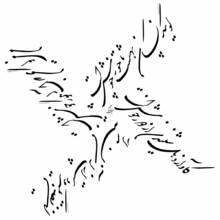
A rubāʿī (Classical Persian: رباعی, romanized: rubāʿī, from Arabic رباعيّ, rubāʿiyy, 'consisting of four, quadripartite, fourfold';[a] plural: رباعيّات, rubāʿiyyāt) or chahārgāna (Classical Persian: چهارگانه) is a poem or a verse of a poem in Persian poetry (or its derivative in English and other languages) in the form of a quatrain, consisting of four lines (four hemistichs).
In classical Persian poetry, the ruba'i is written as a four-line (or two-couplet / two-distich) poem, with a rhyme-scheme AABA or AAAA.[2][3][4][5]
This is an example of a ruba'i from Rumis's Divan-e Shams:
- Anwār-i Ṣalāḥ-i Dīn bar angēkhta bād
- Dar dīda (w)u jān-i ʿāshiqān rēkhta bād
- Har jān ki laṭīf gasht u az luṭf guzasht
- Bā khāk-i Ṣalāḥ-i Dīn dar-āmēkhta bād
- May the splendors of Salahuddin be roused,
- And poured into the eyes and souls of the lovers.
- May every soul that has become refined and has surpassed refinement
- Be mingled with the dust of Salahuddin![6]
- ^ Cowan, J. M., ed. 1994. The Hans Wehr Dictionary of Modern Written Arabic (4th edition). Wiesbaden: Harrassowitz.
- ^ Princeton Encyclopedia of Poetry and Poetics, Princeton University Press, 1974, p.611
- ^ Introduction to The Rubaiyat of Omar Khayyam, translated by Peter Avery and John Heath-Stubbs, Penguin Classics, 1981, ISBN 0-14-044384-3, p. 9 [1]
- ^ The Cambridge History of Iran, v. 4, edited by R. N. Frye, Cambridge University Press, 1999, ISBN 0-521-20093-8, pgs. 633–634 [2]
- ^ Elwell-Sutton, L. P. "The Foundations of Persian Prosody and Metrics," Iran, v. 13 (1975), p. 92.
- ^ "The Splendors of Salahuddin".
Cite error: There are <ref group=lower-alpha> tags or {{efn}} templates on this page, but the references will not show without a {{reflist|group=lower-alpha}} template or {{notelist}} template (see the help page).